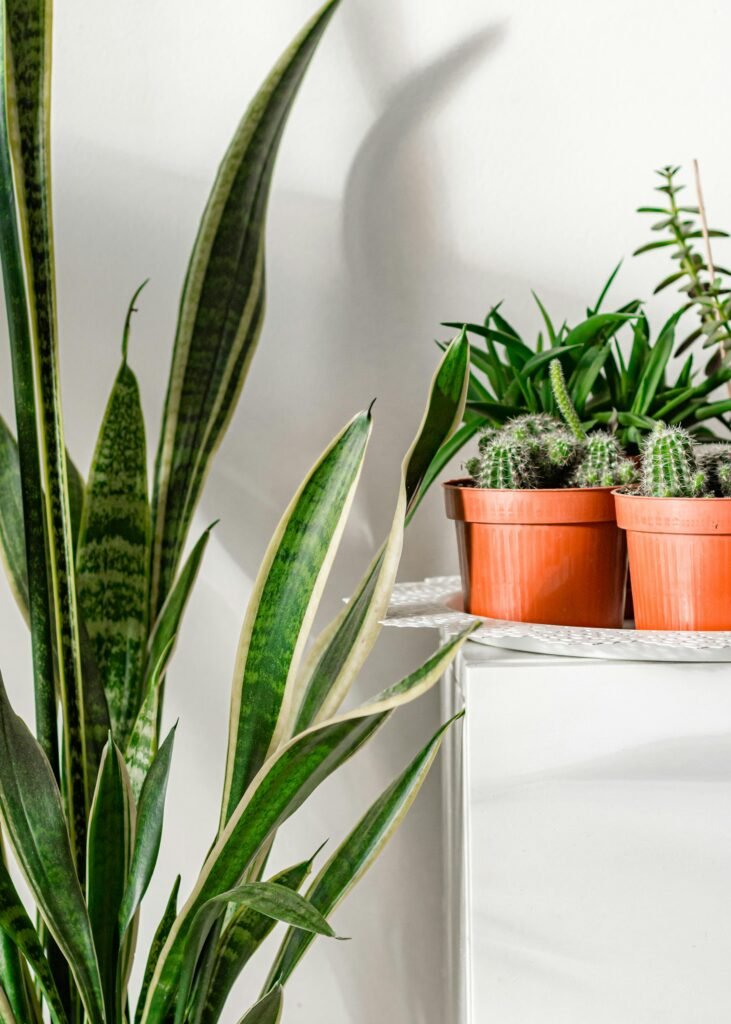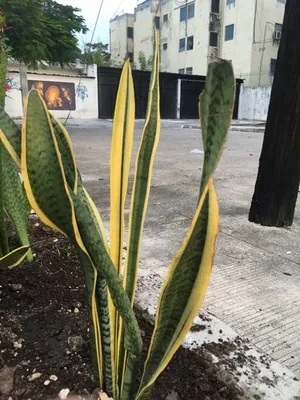Snake Plant Benefits-A Complete Tour

The snake plant, scientifically known as Sansevieria trifasciata, also commonly known as mother-in-law’s tongue or viper’s bowstring hemp, resides among the most highly regarded indoor plants for its striking appearance and remarkable durability. Its tall, sword-shaped leaves feature a geometric design of green and yellow or grayish-green bands splayed across its surface, adding a touch of sophistication to any interior. This tough little plant is a virtual non-nuisance, favoring both low light and infrequent watering, it’s the perfect entry-level choice or option for anyone suffering from “brown thumb syndrome.”
The Snake Plant, as well as having a modern and elegant design to fit any household of the 21st century; is praised for being an excellent air purifier capable of removing toxins such as formaldehyde & benzene from your home. Its special power is it can convert CO2 to Oxygen at nighttime, which makes the indoor air even greater when other plants are basking in the sun. The snake plant’s versatility in front porch decor is what makes it a favorite indoor plant.
Let us take a closer look at the many snake plant benefits and why you should get one for your indoor garden.
Table of Contents
ToggleWhat is Snake Plant
Let’s explore the snake plant benefits, but first, let’s understand what a snake plant is. In terms of design, the snake plant is a stunning addition to any home. Its long, upright leaves, variegated with lime green and yellow, set it apart from other plants with white or plain green leaves. Known as mother-in-law’s tongue Originally from West Africa, this plant is incredibly hardy and versatile, suited to gardeners of all skill levels.
Types of Snake Plant
The Snake Plant (Sansevieria trifasciata) is popularly known for its robustness and eye-catching looks, displaying columns of sword-shaped leaves that give an air of sophistication to your home or office. The usual Snake Plant is the classic, but a few interesting forms exist due to variable patterns, colors, and ways of growth. The following are some of the most common types of Snake Plants:

Sansevieria trifasciata ‘Silver Queen’: This one is recognizable for the upright narrow leaves with interesting silvery-green scales and subtle gray stripes. Its color palette is more gentle, and subdued than other Snake Plant varieties, which makes it perfect for a trendy room, thus adding another high-class touch.
There is a unique metallic sheen to the broad silvery-green leaves of Sansevieria trifasciata ‘Moonshine’, or Moonshine Snake Plant It features pale, luminous foliage that looks perfectly modern and stylish on any background.
Sansevieria trifasciata ‘Hahnii’: Also called the Bird’s Nest Snake Plant, this variety has a neat rosette of shorter, fatter leaves. Growing in a smaller compact form, it is perfect for tabletop and good where space is less space available or too narrow, but has the same bold upright leaves.

Sansevieria cylindrica : Cylindrical Snake Plant, the round tubular leaves of this variety grow vertically and can be tall. That, combined with its unique shape and stiff leaves, gives it a strong architectural quality that makes for a bold move in contemporary interiors.
However, they all have their unique appearance yet share that low-maintenance, tough quality commonly found among most Snake Plants. Whether you like bold yellow borders, white (powdery) tones, or a compact rosette, there is an agreement with the Snake Plant to suit your indoor garden.
Characteristics
Leaves: The Snake Plant is known for its stiff, sword-like, or tongue-shaped leaves. They are usually dark green with lighter greener, silvery, or yellow horizontal bands depending on the type of Aglaonema. In addition to its upright and majestic appearance, the plant possesses a striking architectural appearance, adding a natural flamboyance to any room it graces.
Growing Habit: The Snake Plant grows in a rosette form, and leaves arise from the central base. They grow to heights of 3ft, some types are a little taller. It is quite a slow-growing plant, but in return, it remains very dense and upright enough for most modern indoor environments.
Flowers: Flowering is scarce with indoor Snake Plants, but if it happens you will get small, fragrant tubular flowers on a tall spike Its flowers are usually white or light green and fragrant. It flowers naturally in the wild or under ideal conditions.
Snake Plant Benefits
Air Purification:
Air-purifying power is probably one of the snake plant benefits that comes to mind first. NASA conducted a study that showed snake plants removed substances such as formaldehyde, benzene, xylene, and trichloroethylene from the air. These chemicals are usually present in many household items like cleaning products, paints, furniture, etc. Placing a snake plant in your home can help filter out indoor air pollution and therefore create a healthier living environment.

How it works
What makes the snake plant a powerhouse is that it releases oxygen at night (when photosynthesis stops), whereas other plants, like most trees, take in carbon dioxide and release oxygen during the day. This quality makes them perfect for a bedroom to help purify the air while you are sleeping. Similar to the peace lily, snake plants release oxygen night and day, in contrast to most other plants that largely release oxygen during daylight hours.
Low Maintenance
The most notable benefit of snake plants is that they are simple to care for. Due to their drought tolerance and ability to thrive in low light, snake plants are an ideal choice for individuals who are constantly on the go or those with less gardening skills. You can water snake plants as infrequently as every two weeks (and up to six weeks), depending on humidity and temperature, because they prefer drier dirt. Low maintenance means you can enjoy the benefits of the snake plant with minimal time and effort.
Tips for Care
Light: Many Sansevierias need only indirect light, but they do equally well in low-light conditions.
Water: Overwatering is a frequent mistake. To avoid root rot, wait until the soil is completely dry before watering again.
Temperature: Maintain your snake plant between 70-90°F (21-32°C), but if frost doesn’t affect it, it can withstand even lower temperatures.
Aesthetic Appeal

Snake plants are beautiful and elegant-looking. You can tastefully match the sword-like, long leaves of these plants with any modern or traditional interior. Their one-of-a-kind leaf pattern will also catch your eye immediately, and they are perfect for bringing personality to any space. Furthermore, the visual beauty of the snake plant attracts many individuals interested in its benefits for residential homes.
Decor is versatile.
Living Rooms: Enhance your living room decor by placing a snake plant in a decorative pot.
Bedrooms are perfect for an air-purifying plant. And here, too!
Offices: If you work in an office, putting a Snake plant in your workspace can spruce things up.
Health Benefits
Snake plants not only purify the air but also contribute to good health. Sucking in the air helps prevent airborne allergies and respiratory problems. Furthermore, the higher oxygen levels in snake plants can improve well-being and mental function.
Stress Reduction
Research has shown that contact with plants helps reduce stress and anxiety. Snake Plants can provide a calming effect in your place, which in turn leads to improved mental health.
Pet-friendly (with caution)
While snake plants are generally safe around animals, use caution. The plant contains saponins that, if ingested, could mildly poison cats or dogs. Symptoms often include nausea, vomiting, and diarrhea. To enjoy your snake plant without endangering your cats or dogs, place it away from pets.
Boosting Productivity
Plants make a big difference in the productivity and creativity of your workspace. Snake plants also help to increase focus and concentration, which is perfect for a home office or study area. Not only that, but the benefits of the snake plant go a long way toward improving your mental and emotional health as well.
Sustainability
Snake plants make your house more eco-friendly. They require little watering, and without a greenhouse, they are as diverse as an aeroponics/indoors heading alternative. Choosing snake plants is a step towards sustainable living and carbon neutrality in your environment.
Propagation
The simple propagation of snake plants: Other than it being so easy and inexpensive to do, the snake plant can also be multiplied. Just cut off a healthy leaf and place it in water or soil until you grow roots. This not only helps save on the cost but also encourages responsible gardening. Read more about snake plant benefits here.
Issues and Solutions
The Snake Plant is resilient, but it does run into a few common problems. Here’s how to address them:

Yellowing leaves – Yellow leaves are a common symptom of overwatering or poor drainage. Make sure the pot drains well and leave in between water. To maintain your plant’s attractiveness, prune off any yellow or discolored leaves.
Brown Leaf Tips: The leaves of your Lemon Lime are turning brown, which can be caused by either underwatering, low humidity in the room, or salt buildup from giving too much fertilizer. Monitor soil moisture, boost humidity, or avoid over-fertilization. To enhance its aesthetic, clip the brown tips.
Root Rot: Overwatering and poor drainage are common causes of root rot. If you smell something funky and the roots are squishy, take it out of its pot; trim away any dead or rotting roots, and replace with new well-draining soil.
Pests: The Snake Plant is relatively pest resistant, but can attract spider mites, mealy bugs, and aphids from time to time. If necessary, treat any infestations of aphids with insecticidal soap or neem oil and inspect the plant regularly. Exposure to drafts or extreme temperatures can cause leaf curling. Ensure that you place the plant in a secure environment, shielding it from temperature fluctuations and drafts. You can find more about indoor plant pests here.
Snake plants have become a household staple due to the variety of benefits they provide. Whether air-purifying plants or easy-growing succulents, these tough green treasures have something for every gardener. Adding snake plants to your indoor garden helps to create a greener, healthier, and cleaner home.
Are you now? How can you leverage these benefits, as recommended by Plantophiles? Start by selecting a healthy specimen from your local nursery, and then follow our care instructions to guide it into your home. If you are into gardening and have been doing it for some time, or are a newbie to the world of plants, a snake plant is a good indoor plant choice that will beautify all your interior spaces.
So take advantage of the amazing benefits of having a snake plant in your home and enjoy cleaner air, improved health, and a closer connection with nature.
Most Viewed
Latest Articles





























